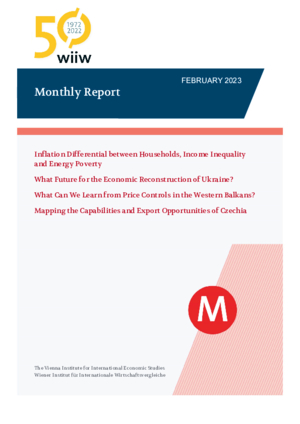Monthly Report No. 2/2023
Tereza De Castro, Branimir Jovanović, Michael Landesmann, Sebastian Leitner, Cristina Procházková Ilinitchi, Ondřej Sankot and Jana Vlčková
wiiw Monthly Report No. 2, February 2023
53 pages including 2 Tables and 28 Figures
- Chart of the Month: Inflation differential between households, income inequality and energy poverty
by Sebastian Leitner
- Opinion Corner: What future for the economic reconstruction of Ukraine?
by Michael Landesmann
Once the vehemence of the military conflict abates, Ukraine has the potential to follow the catch-up experiences of EU-CEE countries. However, this requires massive support and engagement by the EU and other Western partners, and it also needs the institutional and political economy deficiencies that blighted the country in the past to be overcome. Much effort needs to be devoted to reversing outward migration, making the country attractive to foreign investors, rebuilding and modernising its infrastructure and managing the necessary reorganisation of the economy both regionally and structurally.
- What can we learn from price controls in the Western Balkans?
by Branimir Jovanović
Price controls can help curb inflation, but their effectiveness depends on the type of control used. ‘Hard’ price controls – which place a limit on final product prices and do not raise that limit – are effective, whereas controls that limit only profit margins or that raise the price cap over time are not. The strategy for exiting price controls is also important: abolishing them abruptly amidst global price pressures can undo all the hard-won gains.
- Mapping the capabilities and export opportunities of Czechia
by Ondřej Sankot, Jana Vlčková, Cristina Procházková Ilinitchi and Tereza De Castro
Czechia is an exceptionally export-oriented country, with a high level of economic complexity. Its innovative capabilities, however, remain limited. We determine the country’s optimal diversification path by identifying machinery for specialised industries, machine-tools for specialised industries, and pneumatic or non-electric hand tools as the most promising export categories in terms of complexity, expected trade volume growth, and proximity to Czechia’s existing production capabilities and manufacturing base.
- Monthly and quarterly statistics for Central, East and Southeast Europe
Reference to wiiw databases: wiiw Annual Database, wiiw Monthly Database
Keywords: inflation differential, income inequality, energy poverty, EU accession, rule of law, costs of reconstruction, demographic decline, hard price controls, soft price controls, profit margins, food inflation, product space, product complexity index, ARMA/ARIMA models, revealed comparative advantage
Countries covered: Czechia, EU Member States, Ukraine, Western Balkans
Research Areas: Macroeconomic Analysis and Policy, Labour, Migration and Income Distribution, International Trade, Competitiveness and FDI
